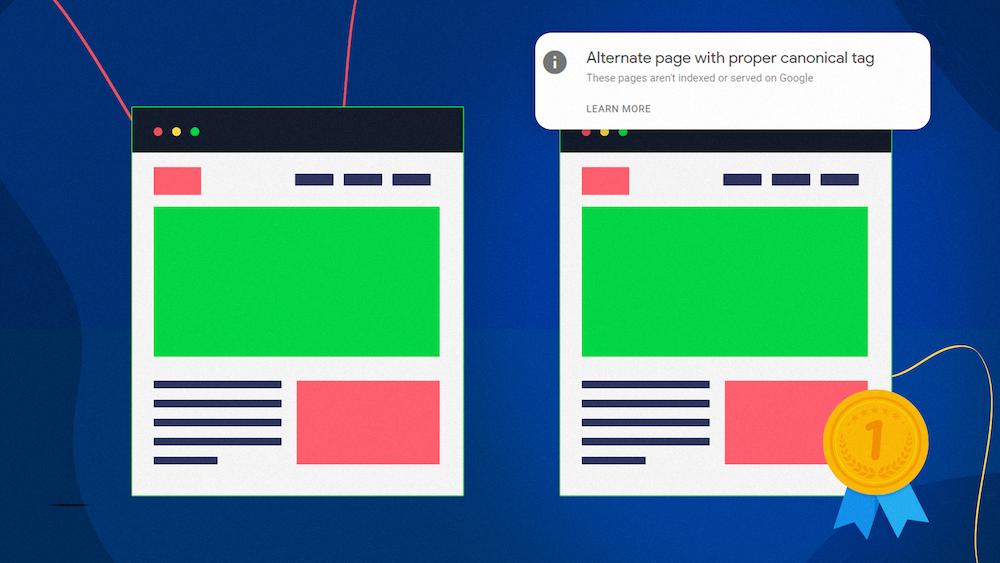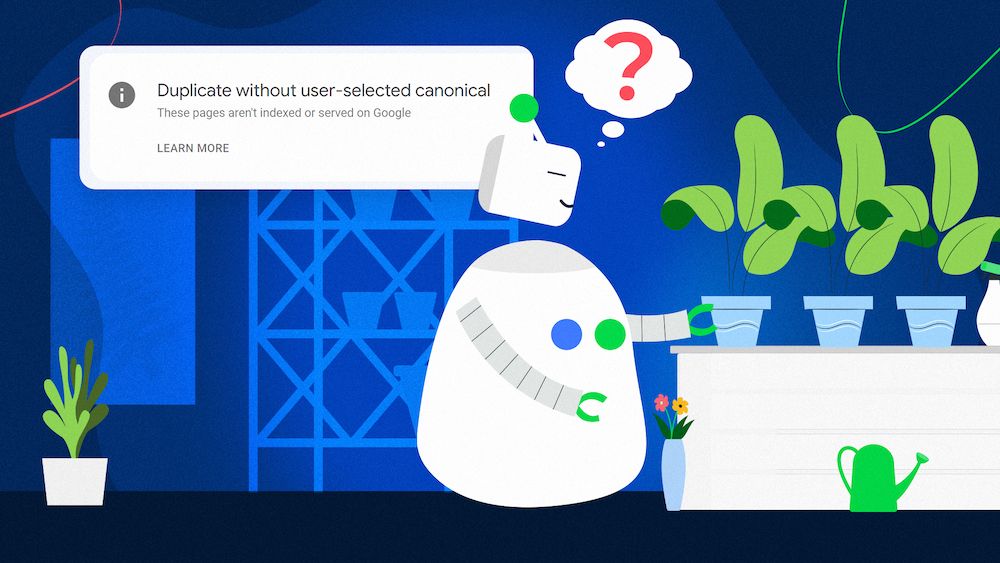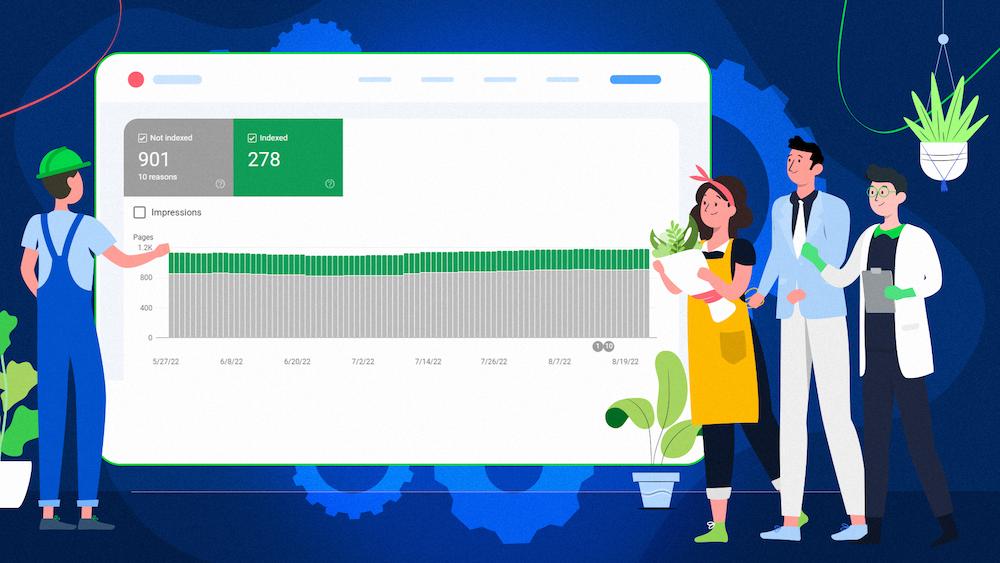“Alternate page with a proper canonical tag” means Google encountered duplicate pages that contain proper canonical tags. Such pages won’t be considered duplicate content. If canonical tags are implemented deliberately, there is nothing to worry about. However, in some cases, this report can help reveal SEO-related problems.
If you are unsure how to approach it, let me guide you through the possible causes and solutions.
What is “Alternate page with proper canonical tag” status?
To give you more context, let’s start with a definition.
Canonical tag is a common name for HTML <link> element with a canonical attribute. This element uses href attribute to mark the original source of the content. For example: if page A is considered a duplicate, it should have a canonical tag linking to the original page B. Canonical can also use the URL of the page we are currently on – in this case, we call it self-referencing canonical.
Code example: <link rel=”canonical” href=”https://www.example.com/page“>
GSC status report “Alternate page with proper canonical tag“ appears when you have multiple versions of the same page. These multiple versions have a canonical tag, which marks a different page as the original.
In other words:
- Pages from “Alternate page with proper canonical tag” report will be properly recognized as copies, and
- pages linked in the canonical tag will be recognized as the original content.
In this case, Google respects the canonical from the source code.If you check the status of the page with the URL Inspection tool, you will see the following information:

How to verify which URLs are affected by “Alternate page with proper canonical tag” report
To access the “Alternate page with proper canonical tag” Report:
1. Navigate to Google Search Console
2. Choose property you want to review

3. Click “Pages” report in the “Indexing” section

4. Go to the “Why pages are not indexed” section and click “Alternate page with proper canonical tag” report

Does the “Alternate page with proper canonical tag” status need fixing?
If you see “Alternate page with proper canonical tag” in the Page indexing (Index Coverage) report in Google Search Console, it probably means:
- You have duplicate or thin content,
- you chose the best version of your content that you wanted to be displayed in search results, or
- you marked your duplicate version with the canonical tag that points to the primary URL.
If you used the canonical tag on purpose, and alternative pages are not contributing further issues, you do not have to change anything.
If you have doubts that your canonicals are implemented correctly, it is necessary to dig deeper into the report.
How to fix the “Alternate page with proper canonical tag” status
If you want to fix “Alternate page with proper canonical tag” status, you need to verify if canonical tags from this report were implemented intentionally as well as why they were implemented. Then you can explore the following scenarios behind “Alternate page with proper canonical tag” status. It is likely that one of them will describe your situation.
Scenario 1: You do not want your alternate page to be indexed, but canonical URL is incorrect
“Alternate page with proper canonical tag” indicates that:
- Google is respecting your canonical tag, and
- it indexed another web page that you deem the preferred version.
However, even if your canonical implementation is respected by Google, it does not mean it is always correct. To troubleshoot it, use the URL Inspection tool to find the current canonical version of your page. You will get a result that looks like this:

“User-declared canonical” means the canonical as implemented in the source code.
If you see that canonical tags are not properly implemented, first you might want to reconsider your approach. Perhaps you do not want Google to crawl nor index alternate pages and it is better to block them from indexing. In this case, use meta robots tag with noindex directive and remove canonical tag from the source code.
If you still want to use canonicals:
- Export a list of affected URLs.
- Run a crawl to find other examples of this issue.
- Analyze the data samples and find common patterns for both the affected URLs and your new preferred canonical URLs – it will make mapping easier, and you might even skip 1:1 mapping completely by using wildcards.
- Determine new canonicals for affected pages.
- Consult implementing these changes with your SEO or Development Teams.
Scenario 2: You want your alternate page to be indexed
If you wish your “Alternate page with proper canonical tag” URL to be indexed, you need to remove the canonical tag pointing to another page.
In this case, you need to:
- Ensure your page provides unique value for users, so Google will not consider it a duplicate, and
- add a self-referential canonical tag – Google recognizes that this page is essential and you want it indexed.
But remember – if you just remove the canonical tag from a given page without changing its content, it will result in duplicate content issues. In this case, after Google crawls your page again, it will likely mark that page as “Duplicate without user-selected canonical” in Google Search Console.
Scenario 3: You do not want alternate pages to exist as separate URLs
If pages from the “Alternate page with proper canonical tag” status report do not serve any purpose on your website, you can consider redirecting them to the original, canonical URL.
In this case you can:
- Export the affected URLs.
- Run a crawl to find other examples of this issue.
- Create a redirect map listing all unwanted alternate pages (as redirect source) and their original, canonical equivalent (as redirect target).
- Implement redirects – use a 301 (permanent) type of redirect.
- Replace all links to alternate pages with links to the original content (redirect target).
However, this may cause you problems if used incorrectly. For example; if you keep the redirected URLs in internal linking, Google will need to crawl two URLs to visit one page. This wastes the crawl budget and can become problematic, especially in case of larger websites.
Before you decide on using redirects, it is best to consult with your SEO Specialist or Developer.
Scenario 4: Your alternate pages are wasting your crawl budget
If you manage a large domain you probably have many alternate URLs, for example; based on your filtering parameters.
Even if you canonicalize them properly, Google may still crawl them extensively. It may happen when you link to these non-canonical pages – on purpose or by accident.
If bots keep crawling your alternative pages instead of focusing on the original content, consider making non-canonical URLs uncrawlable to prevent wasting your crawl budget.
You can check how often Google crawls your URLs by looking at the last crawl date in the URL Inspection tool or performing a crawl analysis using an SEO crawler like Screaming Frog.
But watch out: do not block the crawling of your alternate pages in robots.txt by default. Remember that Google needs to visit your pages in the first place to see the canonical tag.
Also, pay attention to your internal linking:
- Ensure you link internally only to indexable pages that you consider canonical, and
- remove the internal links to your alternate pages that are crawled more than necessary.
Wrapping up
The “Alternate page with proper canonical tag” status usually indicates that you optimize your duplicate content in the right way.
However, canonicalization in SEO can be a complex topic and you should always double-check if the implementation is correct.
Common problems behind this report include:
- Incorrect canonicals, where canonical tag should be changed to another URL or removed in favor of noindex,
- unnecessary canonicals, where canonical tag should be self-referencing,
- canonicals that could be replaced by 301 redirects, and
- alternate pages causing crawl budget issues.
Keep in mind that these are just examples and your situation might be different. If you can not define issues behind the “Alternate page with proper canonical tag” status report – don’t hesitate to ask for help.
Next steps
Here’s what you can do now:
- Contact us.
- Receive a personalized plan to deal with your duplicate content and indexing issues.
- Enjoy your organic traffic.
Still unsure of dropping us a line? Read how technical SEO services can help you improve your website.

Hi! I’m Bartosz, founder and Head of SEO @ Onely. Thank you for trusting us with your valuable time and I hope that you found the answers to your questions in this blogpost.
In case you are still wondering how to exactly move forward with fixing your website Technical SEO – check out our services page and schedule a free discovery call where we will do all the heavylifting for you.
Hope to talk to you soon!






